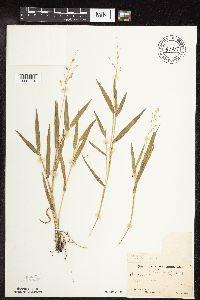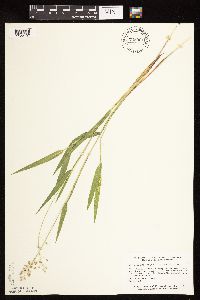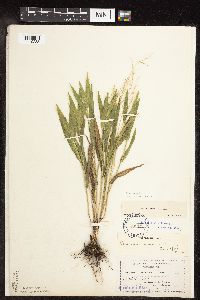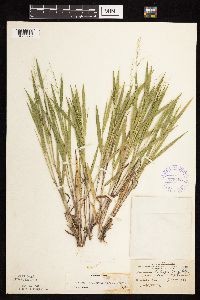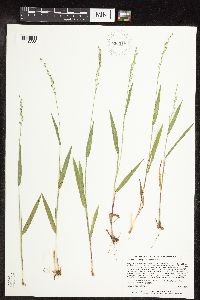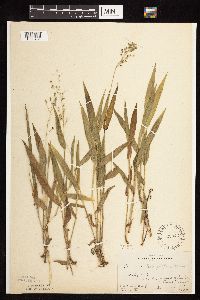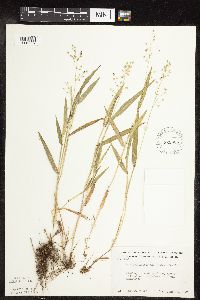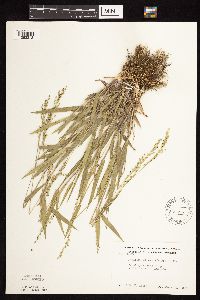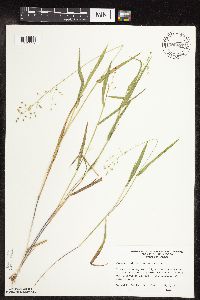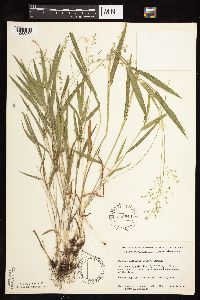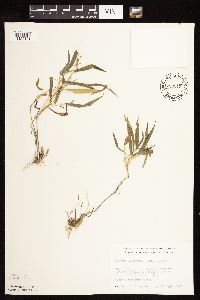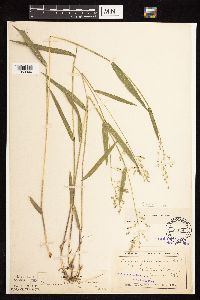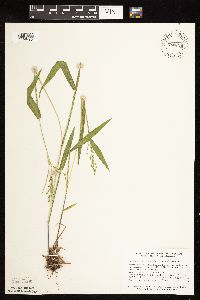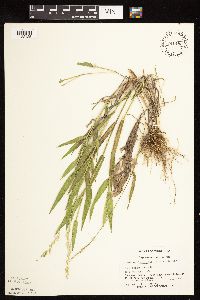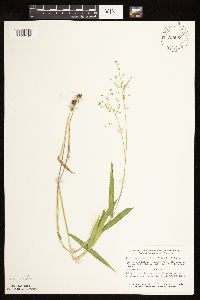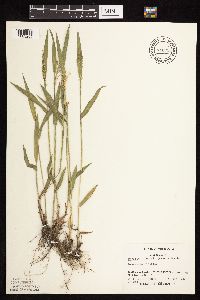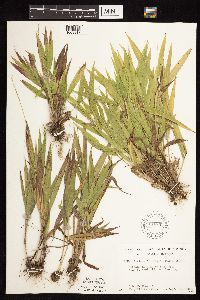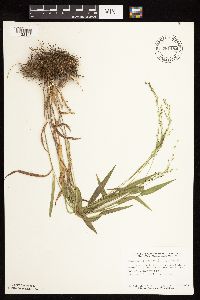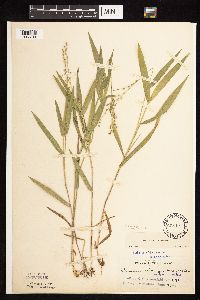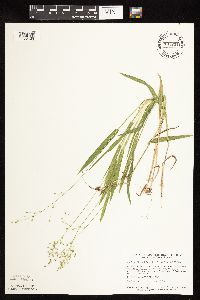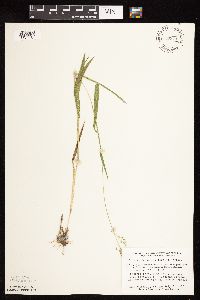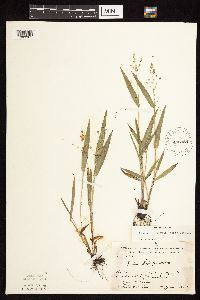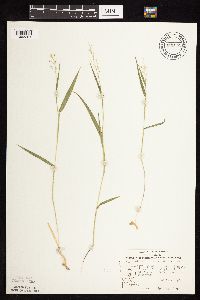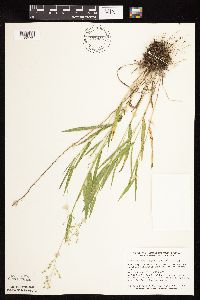Dichanthelium leibergii
|
|
|
|
Family: Poaceae
Leiberg's Witch Grass, more...Leiberg's Panicgrass
[Milium leibergii (Vasey) Lunell] |
Plants cespitose, with knotty rhizomes no more than 2 mm thick. Basal rosettes well-differentiated; blades few, small, ovate to lanceolate. Culms 24-80 cm, glabrous or puberulent; nodes sparsely spreading-pilose; internodes mostly elongated, glabrous or puberulent; fall phase with a few suberect branches from the lower and midculm nodes, blades slightly reduced, secondary panicles partially exserted. Cauline leaves 3-4; sheaths not overlapping, with ascending papillose-based hairs; ligules 0.3-0.5 mm, membranous, ciliate, cilia longer than the membranous portion; blades 5-15 cm long, 7-13 mm wide, ascending to erect, sparsely to densely pubescent with papillose-based hairs, with 9-11 prominent major veins and 25-50 minor veins, bases truncate to cordate, margins with papillose-based cilia. Panicles 6-10 cm long, 3-5 cm wide, their length usually less than twice their width, eventually well-exserted, with 20-40 spikelets; branches spreading to ascending. Spikelets 3.3-3.8 mm long, 1.6-2mm wide, ellipsoid-obovoid, turgid, pubescent, hairs papillose-based, apices rounded. Lower glumes about 1.8 mm, narrowly triangular; lower florets staminate; upper florets mucronate. 2n = 18. Dichanthelium leibergii grows primarily on prairie relics, but is occasionally found in sandy woodlands. The primary panicles are produced from mid-May through July, the secondary panicles from late June to September. Sterile putative hybrids with D. acuminatum and D. xanthophysum are occasionally found. Perennial herb with knotty rhizomes, tufted 24 cm - 0.8 m tall Inflorescence: a terminal, branched arrangement of spikelets (panicle). Primary panicles atop the culms, 6 - 10 cm long, 3 - 5 cm wide, becoming well-exserted, with twenty to forty spikelets. Secondary panicles (when present) atop the branches. Fruit: a caryopsis, indehiscent, enclosed within the persistent lemma and palea. Culm: upright to ascending, 24 cm - 0.8 m long, round in cross-section, hollow, sometimes minutely hairy. Nodes sparsely softly hairy with spreading hairs. Fall phase with a few nearly upright branches from the lower and mid-culm nodes, producing slightly reduced leaf blades and partially exserted secondary panicles. Spikelets: about 3.5 mm long, 1.5 - 2 mm wide, narrowly ellipsoid to reverse egg-shaped with a rounded apex, with bumpy-based hairs. Basal leaves: in a rosette. Blades few, small, egg-shaped to lance-shaped, distinct from stem blades. Stem leaves: three to four, alternate, two-ranked. Sheaths not overlapping, usually shorter than internodes, with ascending, bumpy-based hairs. Ligules to 0.5 mm long, membranous, fringed with hairs (hairs longer than membranous area). Blades upright or ascending, distinctly longer and narrower than basal leaves, 5 - 15 cm long, 7 - 13 mm wide, lance-shaped with a heart-shaped to truncate (cut straight across) base, many-veined, sparsely to densely hairy with bumpy-based hairs, fringed with bumpy-based hairs. Glumes:: Lower glumes over 0.5 mm long, narrowly triangular. Upper glumes rounded to pointed at the apex. Lemmas:: Lower lemmas similar to upper glumes. Upper lemmas longitudinally lined, shiny, with rolled-up margins above. Paleas:: Lower paleas shorter than lower lemmas, thin. Upper paleas longitudinally lined. Florets:: Lower florets male. Upper florets bisexual, stalkless, bearing a short, abrupt tip at the apex, plump. Anthers three. Stigmas red. Similar species: No information at this time. Flowering: mid-May to late August Habitat and ecology: Characteristic of dry prairies. Occurence in the Chicago region: native Etymology: Dichanthelium comes from the Greek words di, meaning twice, and anth, meaning flowering, referring to plants that may have two flowering periods. Leibergii is named after John Bernhard Leiberg (1853-1913), the person who discovered this species. Author: The Morton Arboretum From Flora of Indiana (1940) by Charles C. Deam Very local in the northern part of the state, where it is found in dry, sandy or gravelly soils, usually in prairie habitats. The pH value was taken for only one specimen and it was 6.01. ...... Indiana Coefficient of Conservatism: C = 10 Wetland Indicator Status: FACU |







